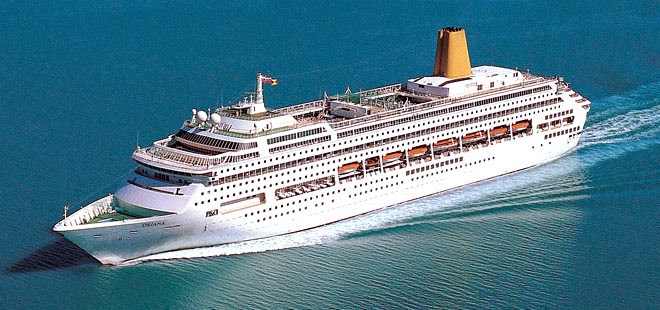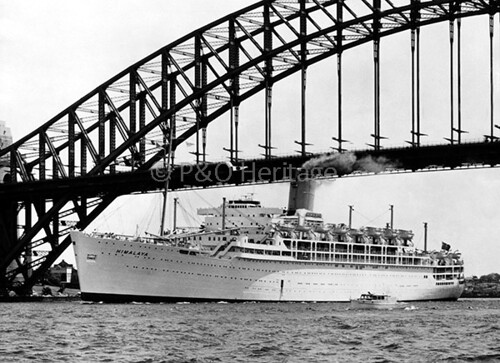 |
| P&O Arcadia in Sydney Harbour (supplied) |
Arcadia is a stylish and beautiful cruise ship. Her design is derived from the Holland America Line's "Vista" class cruise ships. She is specifically designed to operate world voyages and offers a contemporary cruise experience and her stylish design, innovation and signature features set her apart.
Arcadia’s contemporary and innovative character is evident from the moment you step on board. Her exterior glass-fronted lifts afford you panoramic views as you glide from deck to deck. Her Arcadian Rhodes restaurant, created by esteemed British chef Gary Rhodes, offers you a matchless dining experience. This venture sees him working with P&O Cruises for the first time to bring his unique brand of modern cuisine to the high seas.
She combines new ideas with cruising tradition. She has a series of signature features including the Crow's Nest observation lounge, the Palladium - a West End style theatre, and a British pub (The Rising Sun). The ship's public rooms, staterooms and 11 passenger decks also display more than 3000 pieces of modern British art, showcasing the work of 50 of this country's most celebrated contemporary artists. Arcadia has also been designed with adults exclusively in mind. She is a child free ship, with families continuing to be catered for by the other ships in the P&O Cruises fleet.
Arcadia also launched P&O Cruises "New Horizons" programme that will take passengers on a voyage of self discovery. This series of talks, demonstrations and practical sessions in the programme is the way to develop new skills while at the same time unwinding and enriching your time on board. The chance for passengers to expand their interests, undertand more of the world and experience a new cultural activity has become a popular element of today's cruise holiday experience and the New Horizons programme takes this into new places in the 21st century.
The ship is the first in the P&O Cruises fleet to be powered by the revolutionary Azipod propulsion system. She has 6 propulsion pods that offer her unrivalled manouverability and renders traditional rudders obsolete.
Design and Construction (2000 - 2005):
She was actually ordered by Holland America Line in 2000 as the planned fifth "Vista" class cruise ship. However in 2003 she was transferred to Cunard Line to become their Queen Victoria. Shortly before her launch it was decided to transfer her to the P&O Cruises fleet and she became Arcadia.
She was built by Fincantieri Shipbuilders S.p.A. at their Marghera shipyard near Venice in Italy. The float out ceremony took place on the 26th June 2004. Playing a key role in the ceremony was Sabrina Dunkerley, a student at the Warsash Maritime Centre and one of the company's youngest cadets. Together with David Dingle, managing director of Carnival UK, she continued the tradition of placing a specially minted coin under the vessel's mast. It is a ceremony that dates back to Roman times and sailors believe that it brings good luck to passengers and crew of a new ship. Then the cadet sent a bottle of champagne crashing against the ship's side, according to Italian custom, as a signal to allow the water to pour into the dry dock and thus floating out the Arcadia. In December 2004 she undertook her sea trials prior to delivery to P&O Cruises. She was delivered to P&O Cruises on the 20th March 2005 at the Marghera shipyard near Venice.
She was named in Southampton in a lavish ceremony on the 29th March 2005 by Dame Kelly Holmes. The introduction of Arcadia signified the next generation of superliners and represents the evolution of P&O Cruises, as a a holiday experience to appeal to the modern day traveller is developed in the early 21st century.
P&O Cruises era (2005 – Present): She then set sail on her maiden voyage on the 14th April 2005 which was a cruise from Southampton to the Mediterranean. Since then she has enjoyed a successful career with P&O Cruises and throughout the spring, summer and autumn, Arcadia sails to the Mediterranean, Baltic, Scandinavia and the Caribbean. January to March each year sees her undertaking her annual World Cruise, calling at nearly 30 ports of call and taking 90 days to complete.
Today she continues to sail for P&O Cruises and remains a firm favourite with the British cruise market.
by Alex Naughton (originally published at www.poships.co.uk)







